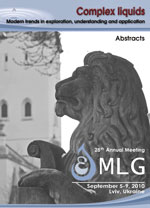On the structure of aqueous electrolyte solutions
Laszlo Pusztai
The microscopic structure of cesium and rubidium halide (e.g., CsCl, CsF, CsBr, CsI, RbCl) solutions, as a function of concentration, has been investigated via neutron and X-ray diffraction, EXAFS and molecular dynamics (MD) simulation. As a means of combining all these techniques, total structure factors from diffraction experiments and partial radial distribution functions from MD have served as input simultaneously for Reverse Monte Carlo (RMC) structural modeling. Based on this approach, it has been shown that, surprisingly, ion-water correlations, as described by several interatomic potential sets, can be consistent (within errors!) with diffraction data. On the other hand, water-water correlations from MD are much less reliable. Finally, a detailed description of the structural parameters, such as the (distribution of the) number of first neighbors and angular distributions within the first coordination shell, will be provided.



